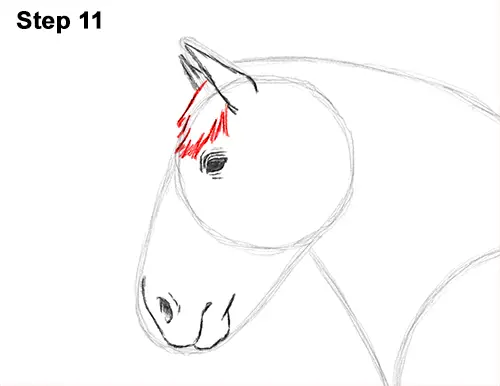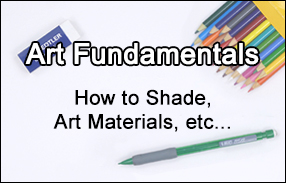
Step 10: Darken the sides of the triangle- like shape on top of the horse's head to create the first ear. Extend the lines for the base of the ear inward toward the head a bit more. Draw a small angled line on the left for the tip of the other ear. Don't draw the bottom part of it.

Step 11: Draw the front part of the horse's mane between the ears using a series of long lines. Draw the tips of the mane and its basic shape as a clump instead of drawing every individual hair strand.

Step 12: Use the initial circle and arc as guides to draw the rest of the horse's head. Follow the basic path of the guides but make the shape of the head a bit narrower, especially the bottom part. Add a curved line on the right side of the head for the strong jaw muscles. Draw a series of lines within the head to give the head more shape and structure.

Step 13: Use the second line from the left under the body as a guide to draw the first front leg. Lightly sketch the shape of the leg as you follow the basic path of the guide line. Clydesdale and shire horses have very thick, muscular legs compared to, say, Arabians, so make the shape of the legs thick.
Use light strokes to begin so that they're easy to erase if you make a mistake. Darken the lines when you get the shape right. As you darken the bottom part, make the shape wider to represent the extra hair called "feathers" found there. Use a series of quick, short strokes along the bottom edge to represent the tips of the feathers. Use curved lines as you darken the shape to represent the horse's joints and muscle structure of the leg.
Draw the visible portion of the horse's hoof at the bottom but don't draw too much of it because the feathers should cover up most of it. Add a few lines inside the leg for extra detail on the muscles. You can also make the shape wider at the bottom if you'd like more feathers.

Step 14: Now use the leftmost line under the body as a guide to draw the other front leg the same way. Lightly sketch the shape of the leg as you follow the basic path of the guide line. The horse is stepping forward, so bend the shape and lift the leg up off the ground.
When you get the shape right, darken the lines. Use curved lines throughout to indicate the muscles and joints. Make the bottom of the horse's leg wider and use quick, short strokes on the edge to represent the feathers. Add the visible portion of the hoof as a short line peeking through the right side of the feathers.







